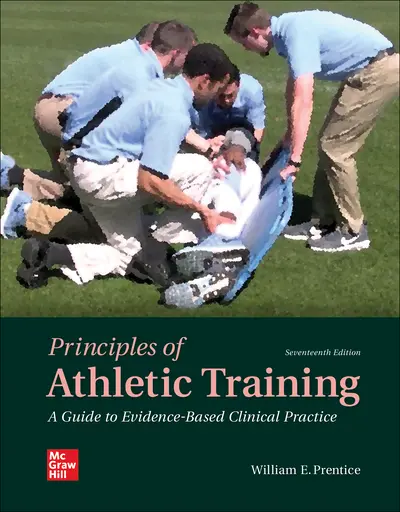My Account Details

ISBN10: 126024105X | ISBN13: 9781260241051

* The estimated amount of time this product will be on the market is based on a number of factors, including faculty input to instructional design and the prior revision cycle and updates to academic research-which typically results in a revision cycle ranging from every two to four years for this product. Pricing subject to change at any time.
Instructor Information
Quick Actions (Only for Validated Instructor Accounts):
Principles of Athletic Training: A Guide to Evidence-Based Clinical Practice is designed to be used by athletic trainers in courses concerned with the scientific, evidence-based and clinical foundations of athletic training and sports medicine. The text is developed with the goal of helping prepare students to become competent health care professionals who will continue to enhance the ongoing advancement of the athletic training profession. The text leads the student from general foundations to specific concepts relative to injury prevention, evaluation, management, and rehabilitation. As the student progresses from beginning to end, he or she will understand the complexities of the profession of athletic training. An over-arching goal of the text is to incorporate the best available evidence to support the recommendations being made relative to patient care. After using this text the student should be able to apply the appropriate techniques and concepts in the day-to-day performance of his or her job as an athletic trainer. Practicing athletic trainers, physical therapists, and other health care professionals involved with physically active individuals will also find this text valuable.
McGraw-Hill Connect® is a subscription-based learning service accessible online through your personal computer or tablet. Choose this option if your instructor will require Connect to be used in the course. Your subscription to Connect includes the following:
SmartBook® 2.0- an adaptive digital version of the course textbook that personalizes your reading experience based on how well you are learning the content. Access to your instructors homework assignments, quizzes, syllabus, notes, reminders, and other important files for the course.Progress dashboards that quickly show how you are performing on your assignments and tips for improvement.
Part 1 Professional Development and Responsibilities
CHAPTER 1: The Athletic Trainer as a Health Care Provider
CHAPTER 2: Health Care Organization and Administration in Athletic Training
CHAPTER 3: Legal Concerns and Insurance Issues
Part 2 Risk Management
CHAPTER 4: Fitness and Conditioning Techniques
CHAPTER 5: Nutrition and Supplements
CHAPTER 6: Environmental Considerations
CHAPTER 7: Protective Equipment
CHAPTER 8: Wrapping and Taping
Part 3 Pathology of Sports Injury
CHAPTER 9: Mechanisms and Characteristics of Musculoskeletal and Nerve Trauma
CHAPTER 10: Tissue Response to Injury
Part 4 Management Skills
CHAPTER 11: Psychosocial Intervention for Sports Injuries and Illnesses
CHAPTER 12: On-the-Field Acute Care and Emergency Procedures
CHAPTER 13: Off-the-Field Injury Evaluation
CHAPTER 14: Infectious Diseases, Bloodborne Pathogens, and Universal Precautions
CHAPTER 15: Using Therapeutic Modalities
CHAPTER 16: Using Therapeutic Exercise in Rehabilitation
CHAPTER 17: Pharmacology, Drugs, and Sports
Part 5 Musculoskeletal Conditions
CHAPTER 18: The Foot
CHAPTER 19: The Ankle and Lower Leg
CHAPTER 20: The Knee and Related Structures
CHAPTER 21: The Thigh, Hip, Groin, and Pelvis
CHAPTER 22: The Shoulder Complex
CHAPTER 23: The Elbow
CHAPTER 24: The Forearm, Wrist, Hand, and Fingers
CHAPTER 25: The Spine
Part 6 General Medical Conditions
CHAPTER 26: The Head, Face, Eyes, Ears, Nose, and Throat
CHAPTER 27: The Thorax and Abdomen
CHAPTER 28: Skin Disorders
CHAPTER 29: Additional General Medical Conditions
Appendix A: Addresses of Professional Sports Medicine Organizations
Appendix B: NATA Position, Official, Consensus, and Support Statements
Appendix C: Sports Medicine–Related Journals
Appendix D: The Process Leading to CAATE Accreditation of the Athletic Trainer as an Allied Health Care Professional
Appendix E: Sample Resume
Appendix F: NATA Code of Ethics
Appendix G: Manual Muscle Tests
Appendix H: Goniometric Measurements of Range of Motion
Need support? We're here to help - Get real-world support and resources every step of the way.